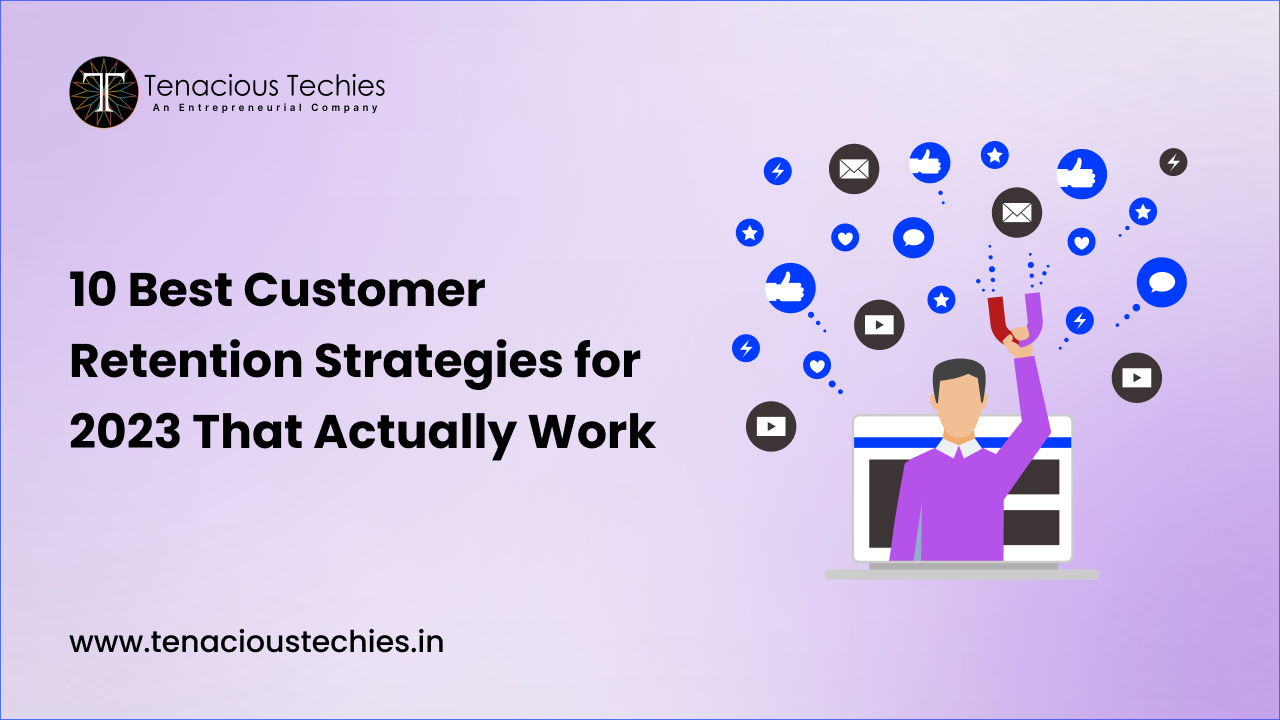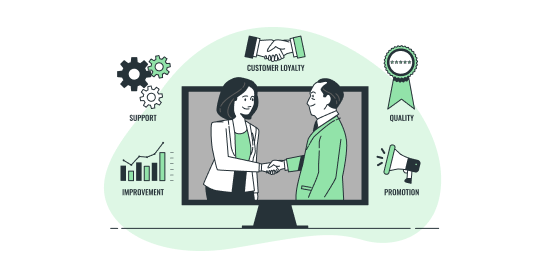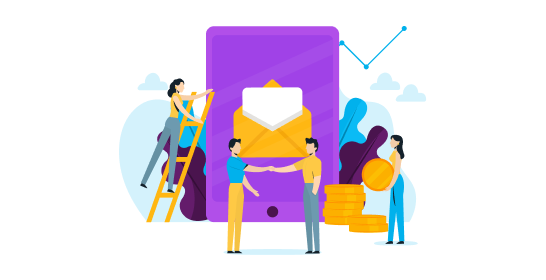
Definition and importance of customer retention
Customer retention is the process of customers keeping existing engaged and coming back for more. It is one of the most important factors for business success, as it is much more cost-effective to retain existing customers than to acquire new ones.
Overview of how digital marketing can contribute to customer retention
Digital marketing can play a vital role in customer retention by helping businesses to:
- Build strong customer relationships: Digital marketing channels, such as email marketing and social media, allow businesses to interact with customers on a more personal level and build stronger relationships with them.
- Personalize customer experiences: Digital marketing tools and technologies enable businesses to collect data about their customers and use it to personalize their experiences, such as by sending targeted messages and offers.
- Reward customer loyalty: Digital marketing can be used to implement loyalty programs and rewards programs that incentivize customers to keep coming back.
- Provide excellent customer service: Digital channels can be used to provide fast and responsive customer support, which is essential for retaining customers.
Understanding Your Customer Base

Utilizing customer segmentation to identify different customer groups
Customer segmentation is the process of dividing your customer base into different groups based on shared characteristics, such as demographics, interests, and purchase behavior.
This allows you to better understand the needs and preferences of each customer group and tailor your marketing messages and offers accordingly.
Conducting market research to gather insights on customer needs, preferences, and behaviors
Market research can help you to learn more about your customers’ needs, preferences, and behaviors. This information is essential for developing effective customer retention strategies.
Some of the most common market research methods include:
- Surveys: Surveys allow you to collect quantitative data from a large number of customers.
- Interviews: Interviews allow you to collect in-depth qualitative data from a smaller number of customers.
- Focus groups: Focus groups allow you to gather feedback and insights from a group of customers on a specific topic.
Personalization and Targeted Messaging
Implementing personalized marketing strategies based on customer data
Once you have a good understanding of your customer base, you can start to implement personalized marketing strategies.
This involves using customer data to deliver targeted messages and offers that are relevant to each individual customer.
Some examples of personalized marketing strategies include:
- Sending personalized email campaigns: You can use email marketing to send personalized email campaigns to different customer groups based on their demographics, interests, and purchase behavior.
- Showing targeted ads: You can use online advertising platforms, such as Google Ads and Facebook Ads, to show targeted ads to customers who have visited your website or interacted with your brand on social media.
- Recommending products: You can use product recommendation engines to recommend products to customers based on their past purchase history and browsing behavior.
Crafting targeted messages and offers to address individual customer interests and pain points
When crafting targeted messages and offers, it is important to focus on the individual customer’s interests and pain points. What are they looking for? What problems are they trying to solve?
By addressing the customer’s individual needs and wants, you can create more relevant and compelling messages and offers that are more likely to resonate with them.
Building Customer Loyalty through Email Marketing

Designing and implementing automated email campaigns
Automated email campaigns are a great way to stay in touch with your customers and nurture customer relationships.
You can use automated email campaigns to send customers welcome emails, birthday emails, abandoned cart emails, and other types of personalized messages.
Sending personalized and relevant content
When sending email marketing messages, it is important to focus on sending personalized and relevant content. Your email messages should be informative, engaging, and relevant to the recipient’s interests.
You can personalize your email messages by using the recipient’s name, mentioning their past purchases, and recommending products that they are likely to be interested in.
Utilizing email marketing to promote loyalty programs
Email marketing can be used to promote loyalty programs and rewards programs to customers. You can send email campaigns to inform customers about the benefits of joining your loyalty program and encourage them to sign up.
You can also use email marketing to send customers exclusive offers and rewards for being loyal customers.
Also read: Digital marketing for startups
Leveraging Social Media for Customer Retention

Engaging with customers through social media platforms
Social media is a great platform for engaging with customers and building relationships with them. You can use social media tools to post interesting content, answer customer questions, and resolve customer issues.
Here are some tips for engaging with customers on social media:
- Post regularly: Post new content on a regular basis to keep your audience engaged.
- Share interesting content: Share content that is relevant to your target audience and that they will find interesting and informative.
- Interact with your followers: Respond to comments and questions from your followers. This shows that you are interested in what they have to say and that you value their feedback.
- Resolve customer issues: If a customer has a complaint or issue, use social media to resolve it promptly and efficiently. This shows that you are committed to providing excellent customer service.
Sharing valuable content, promotions, and exclusive offers
You can also use social media to share valuable content, promotions, and exclusive offers with your followers. This is a great way to keep your customers engaged and coming back for more.
Here are some tips for sharing valuable content, promotions, and exclusive offers on social media:
- Share high-quality content: Share content that is informative, engaging, and visually appealing.
- Promote your products and services: Use social media to promote your products and services in a way that is informative and not too pushy.
- Offer exclusive discounts and promotions: Offer exclusive discounts and promotions to your social media followers. This is a great way to show your followers that you appreciate their loyalty.
Encouraging user-generated content and customer testimonials
User-generated content (UGC) is any content that is created by your customers, such as product reviews, photos, and videos. UGC is a great way to build trust and credibility with your target audience.
You can encourage UGC by running social media contests and giveaways, and by featuring your customers’ content on your social media pages.
Customer testimonials are another great way to build trust and credibility. When customers share their positive experiences with your brand, it encourages other potential customers to do business with you.
You can encourage customers to leave testimonials by sending them follow-up emails after they have made a purchase, and by featuring testimonials on your website and social media pages.
Providing exceptional Customer Service
Offering fast and responsive customer support through email, live chat, or social media
Providing excellent customer service is essential for retaining customers. You can use digital channels, such as email, live chat, and social media, to offer fast and responsive customer support.
Here are some tips for providing excellent customer service through digital channels:
- Respond to customer inquiries promptly: Always try to respond to customer inquiries as promptly as possible. This shows that you are interested in resolving their issue and that you value their time.
- Be helpful and polite: When responding to customer inquiries, be helpful and polite. This shows that you are committed to providing a positive customer experience.
- Go the extra mile: Sometimes, it takes going the extra mile to make a customer happy. If a customer is having a particularly difficult issue, try to go the extra mile to resolve it. This will show the customer that you are truly committed to providing them with a positive experience.
Using chatbots or AI-driven solutions to enhance customer service experience
Chatbots and AI-driven solutions can be used to enhance the customer service experience. Chatbots can be used to answer common customer questions and provide support 24/7.
AI-driven solutions can be used to personalize the customer experience and provide more proactive support.
Monitoring online reviews and addressing customer feedback
It is important to monitor online reviews and address customer feedback promptly. This shows that you are listening to your customers and that you are committed to resolving their issues.
When responding to negative reviews, be sure to apologize for the customer’s experience and offer to resolve the issue. When responding to positive reviews, be sure to thank the customer for their feedback.
Using Retargeting and Remarketing Techniques
Implementing retargeting ads to reach customers
Retargeting ads are ads that are shown to customers who have already visited your website or interacted with your brand on social media.
It can be a very effective way to reach customers who are already interested in your products or services.
Customizing advertisements based on customer behavior and preferences
You can customize your retargeting ads based on customer behavior and preferences. For example, you can show ads for products that customers have viewed on your website or for products that are similar to products that they have purchased in the past.
You can also use retargeting ads to promote specific offers or discounts to customers. For example, you can offer a discount to customers who have abandoned their carts or to customers who haven’t made a purchase in a while.
Implementing cart abandonment strategies to recover potentially lost customers
Cart abandonment is a common problem for e-commerce businesses. Customers may add items to their carts but then leave without completing their purchase.
You can use cart abandonment strategies to recover potentially lost customers. Such as, you can send abandoned cart emails to customers who have left items in their carts.
These emails should be timely and personalized, and they should offer customers a reason to complete their purchase, such as a discount or free shipping.
Creating Engaging Content for Customer Retention
Developing valuable and relevant content
One of the best ways to retain customers is to create valuable and relevant content that addresses their needs. This could include blog posts, articles, videos, podcasts, or even infographics.
When creating content, it is important to focus on the needs of your target audience. What are their interests? What problems are they trying to solve?
By creating content that addresses the needs of your target audience, you can position yourself as an expert in your field and build trust with your customers.
Sharing content through blog posts, videos, podcasts, or social media
You can share your content through blog posts, videos, podcasts, or social media. This will help you to reach a wider audience and increase brand awareness.
When sharing your content, be sure to use relevant keywords and hashtags so that people can easily find it. You should also promote your content on social media and in your email marketing campaigns.
Encouraging customer interaction through comments, likes, and shares
It is important to encourage customer interaction with your content. This could involve asking questions, running contests, or simply promoting your content on social media.
By encouraging customer interaction, you can build relationships with your customers and increase customer loyalty.
Measuring and Analyzing Customer Retention Efforts
Identifying key metrics
There are a number of key metrics that you can use to measure customer retention success. Some of the most common metrics include:
- Customer churn rate: This metric measures the percentage of customers who stop doing business with you over a period of time.
- Customer lifetime value (CLV): This metric measures the average amount of money that a customer spends over their lifetime relationship with your business.
- Net promoter score (NPS): This metric measures how likely customers are to recommend your business to others.
By tracking these metrics, you can measure the success of your customer retention efforts and make necessary adjustments.
Using analytics tools to track customer behavior and engagement
You can use analytics tools to track customer behavior and engagement. This information can be used to identify areas where you can improve your customer retention efforts.
For example, you can use google analytics to track which pages customers visit on your website and how long they stay on those pages.
This information can be used to identify pages that are not engaging customers and to make necessary changes.
Analyzing data to understand trends
Once you have collected data on customer behavior and engagement, you can analyze it to understand trends and make informed decisions about your customer retention efforts.
You may notice that a certain segment of your customers is more likely to churn than others. You can use this information to develop targeted customer retention programs for this segment of customers.
Building and Sustaining Customer Advocacy
Encouraging satisfied customers
Create a community around your brand: You can create a community around your brand by hosting events, creating social media groups, and offering exclusive content. This will give customers a place to connect with each other and with your brand.
Ask for referrals: You can ask satisfied customers to refer your business to their friends and family. This is a great way to generate new leads and customers.
Make it easy for customers to share their feedback: Make it easy for customers to share their feedback on social media, on your website, and through other channels. This will help you to build trust and credibility with potential customers.
Implementing referral programs and offering incentives for customer referrals
Referral programs are a great way to encourage satisfied customers to refer your business to their friends and family. You can offer incentives for customer referrals, such as discounts, free products, or points that can be redeemed for rewards.
When implementing a referral program, be sure to make it easy for customers to participate and to redeem their rewards. You should also promote your referral program on your website, in your email marketing campaigns, and on social media.
Leverage positive customer reviews and testimonials
Positive customer reviews and testimonials are a valuable marketing tool. They can help you to build trust and credibility with potential customers and to increase sales.
You can leverage positive customer reviews and testimonials in your marketing campaigns by featuring them on your website, in your email marketing campaigns, and on social media. And also use customer reviews and testimonials in your advertising campaigns.
Case Studies and Best Practices
Examining successful customer retention strategies
There are a number of successful customer retention strategies that you can learn from. You can examine successful customer retention strategies from different industries to see what works best for your business.
For example, you can learn from customer retention strategies used by companies like Amazon, Starbucks, and Netflix.
These companies are known for having loyal customers who keep coming back for more.
Learning from real-life examples and identifying best practices
You can also learn from real-life examples of successful customer retention strategies. You can find case studies and articles about successful customer retention strategies online and in business publications.
When learning from real-life examples, be sure to identify the best practices that you can apply to your business. Keep in mind that every business is different, so what works for one business may not work for another.
Actionable Steps and Next Steps
Creating an action plan to implement digital marketing strategies
Once you have learned about different customer retention strategies, you can create an action plan to implement them in your business. Your action plan should include the following:
- Specific goals: What do you want to achieve with your customer retention strategies? Do you want to reduce customer churn, increase customer lifetime value, or improve customer satisfaction?
- Target audience: Who are you trying to reach with your customer retention strategies?
- Strategies: What customer retention strategies are you going to implement?
- Tactics: How are you going to implement your customer retention strategies?
- Timeline: When are you going to implement your customer retention strategies?
- Budget: How much money are you going to spend on your customer retention strategies?
Identifying resources and tools
There are a number of resources and tools available to help you with your customer retention efforts.
You can use analytics tools to track customer behavior and engagement, and you can use email marketing tools to send targeted email campaigns to your customers.
You can also find a number of resources and tools online, such as blog posts, e-books, and webinars.
These resources can teach you about different customer retention strategies and how to implement them in your business.
Monitoring and evaluating progress and making adjustments
Once you have implemented your customer retention strategies, it is important to monitor and evaluate your progress. This will help you to see what is working and what is not working.
You can use analytics tools to track key metrics, such as customer churn rate, customer lifetime value, and net promoter score. You should also collect feedback from your customers to see how they are responding to your customer retention efforts.
Based on your monitoring and evaluation, you can make adjustments to your customer retention strategies as needed.
Summing up!
Customer retention is the golden goose of digital marketing. It’s much easier and cheaper to keep a customer than to acquire a new one. So why not invest in strategies that will help you keep your customers coming back for more?
By following the tips above, you can use digital marketing to build stronger relationships with your customers, personalize their experiences, and reward their loyalty. This will lead to happier customers, more repeat business, and a healthier bottom line.


